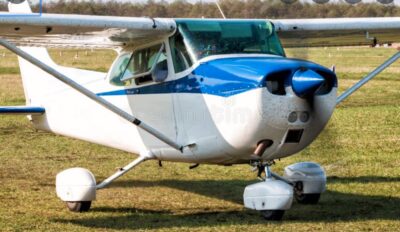Ever had a close call? We all have, and it can be unnerving. Sometimes “they” just come out of the blue but there are tools at our disposal and we should be using them all the time. In the air we have ATC, TIS-B displays, and audio warnings but no matter where you are, the most useful tool in our toolbox is the human eyeball. In the process of getting a private pilot’s license, we all learned about the workings of the eyeball – its strengths and its shortcomings. FAA recently released an updated Advisory Circular AC 90-48E Pilot’s Role in Collision Avoidance. It’s a pretty quick read and is good stuff, dealing with the limitations of human sight, the importance of technology, the necessity of preflight planning, chart interpretation, and good communication.
On the ground, here’s a technique followed by professional pilots around the world. It works; it’s helpful and it’s courteous to other pilots.  Turn ON the taxi light (not the landing light) when the aircraft is moving or intending to move on the ground, but turn it OFF
Turn ON the taxi light (not the landing light) when the aircraft is moving or intending to move on the ground, but turn it OFF  when you stop or yield… then back ON when you move. This tells other pilots what you are doing or intending to do. If, for example, you’re holding short of the runway awaiting landing traffic, your taxi light would be off, in effect telling the landing pilot that you’re not about to enter the runway. You can also turn your taxi light OFF to signal to another pilot that you are yielding. Strobe lights should be OFF during taxi unless it’s your only anti-collision light, like in the Diamond. That’s to avoid distractions to other pilots.
when you stop or yield… then back ON when you move. This tells other pilots what you are doing or intending to do. If, for example, you’re holding short of the runway awaiting landing traffic, your taxi light would be off, in effect telling the landing pilot that you’re not about to enter the runway. You can also turn your taxi light OFF to signal to another pilot that you are yielding. Strobe lights should be OFF during taxi unless it’s your only anti-collision light, like in the Diamond. That’s to avoid distractions to other pilots.
Crossing a Runway. Turn on every light you’ve got when crossing a runway, but then return to the lighting you had before.
Entering the Departure Runway for Takeoff. When entering a runway for takeoff make yourself conspicuous by turning on all lights except for landing lights (and strobes if it’s dark and there are other planes nearby). Then when you’re starting your takeoff, turn on your landing lights and strobes.
Another AC was re-issued relatively recently – also chock full of helpful info that can help avoid close-calls – Non-Towered Airport Flight Operations AC 90-66B. This should be mandatory reading for all GA pilots since we spend so much time at non-towered airports. It’s always helpful to remind yourself of the “best practices”